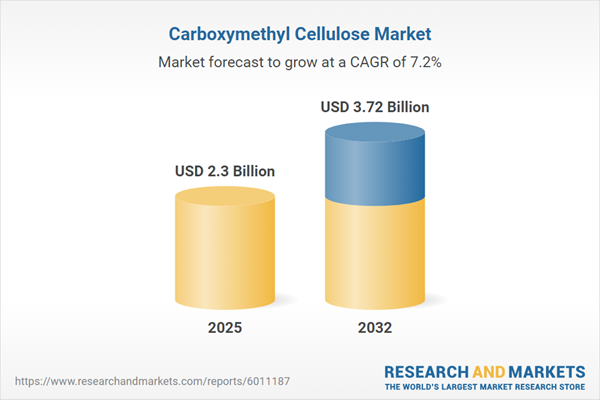Speak directly to the analyst to clarify any post sales queries you may have.
The carboxymethyl cellulose (CMC) market is critical for senior leaders managing operational performance and compliance in sophisticated supply networks. With the growing intricacy in manufacturing and regulatory landscapes, clear CMC market intelligence empowers timely strategic decisions for long-term and sustainable business development.
Market Snapshot: Carboxymethyl Cellulose Market
The global carboxymethyl cellulose (CMC) market is consistently progressing, influenced by production innovation, changing regulations, and stronger requirements for uniform product quality. As new sector standards develop, applications requiring precise traceability and reliability are expanding across industries. Manufacturers are adapting by harnessing CMC’s flexible characteristics to reinforce value chains, ensuring resilient operations. Organizations that focus on timely technology adoption and monitor global shifts position themselves to capitalize on changing expectations around manufacturing excellence and compliance. Continuous sector development signals new opportunities for those who stay ahead of upcoming market shifts.
Scope & Segmentation of the Carboxymethyl Cellulose Market
- Types: Both calcium carboxymethyl cellulose and sodium carboxymethyl cellulose address varied solubility profiles and operational requirements, supporting applications spanning industrial and consumer segments.
- Forms: Granular and powder CMC enable seamless integration into modern and legacy processing environments, maximizing flexibility, consistent processing, and effective production outcomes.
- Grades: Specialized CMC grades target cosmetic, food, industrial, and pharmaceutical segments, each fulfilling strict compliance and quality requirements for different production needs, from high-volume to niche customizations.
- Applications: CMC use spans detergents, food and beverage processing, paper manufacturing, personal care, cosmetics, pharmaceuticals, and textiles. In each application, CMC supports operational workflow reliability, process efficiency, and regulatory alignment.
- Regional Coverage: The CMC market has strong representation in the Americas, Europe, the Middle East and Africa, and Asia-Pacific. Strategic activity in the United States, Brazil, Mexico, China, India, and Germany drives trends in compliance, logistics, and procurement policy across diverse regulatory landscapes.
- Key Companies: Industry leaders such as CP Kelco U.S. Inc., Ashland Inc., Dow Inc., Fonterra Co-operative Group Limited, SE Tylose GmbH & Co. KG, Nippon Paper Industries Co., Ltd., J. Rettenmaier & Söhne GmbH + Co. KG, Lamberti S.p.A., DKS Co., Ltd., and Foodchem International Corporation play pivotal roles, advancing market development through technical innovation and elevated manufacturing standards.
Key Takeaways for Strategic Leaders
- CMC serves as a compliance enabler, allowing suppliers and manufacturers to meet strict transparent-label standards and accelerate entry to newly regulated segments.
- Adoption of green chemistry and advanced filtration technologies in CMC manufacturing helps organizations achieve sustainability targets and environmental benchmarks.
- Diversified sourcing and distribution support rapid response in high-growth sectors, including advanced personal care and digital printing, minimizing exposure to disruptions.
- Vigilant regulatory tracking, combined with end-to-end supply oversight, enhances risk management and prepares operations for policy changes or logistical challenges.
- Building robust infrastructure and fostering collaborative business relationships provides resilience in the face of evolving market and compliance conditions.
- Strengthened ethical sourcing and supply chain transparency secure stakeholder trust and bolster long-term brand reputation in a competitive market.
Tariff Impact and Trade Dynamics
Changes in United States tariffs have influenced procurement strategies within the carboxymethyl cellulose market, causing domestic companies to re-evaluate sourcing options and refine budget planning. As global trade dynamics intensify, organizations are implementing agile supply solutions to maintain operational flexibility and consistent performance amidst unpredictable regulatory and competitive pressures. The need for adaptive sourcing and risk-aware logistics management becomes increasingly important for sustaining competitiveness and steady growth.
Methodology & Data Sources
This analysis draws on expert stakeholder interviews, in-depth regulatory and technical assessments, and systematic reviews of market and manufacturing documentation. All key findings are validated through recognized industry channels, maintaining thoroughness and direct applicability for strategic executive planning and investment decisions.
Why This Report Matters for Senior Decision-Makers
- Guides strategic navigation through shifting global supply chains, evolving regulations, and new technologies affecting the CMC sector.
- Enables precise risk identification and the deployment of effective mitigation approaches in both established and developing end-use markets.
- Supports decision-making by highlighting opportunities to maximize resource efficiency and formulate targeted geographic and operational growth strategies.
Conclusion
This report gives executive leadership the essential strategic perspective needed to update business frameworks, reinforce competitive positioning, and adapt confidently within the rapidly advancing carboxymethyl cellulose market.
Additional Product Information:
- Purchase of this report includes 1 year online access with quarterly updates.
- This report can be updated on request. Please contact our Customer Experience team using the Ask a Question widget on our website.
Table of Contents
3. Executive Summary
4. Market Overview
7. Cumulative Impact of Artificial Intelligence 2025
Companies Mentioned
The companies profiled in this Carboxymethyl Cellulose market report include:- CP Kelco U.S., Inc.
- Ashland Inc.
- Dow Inc.
- Fonterra Co-operative Group Limited
- SE Tylose GmbH & Co. KG
- Nippon Paper Industries Co., Ltd.
- J. Rettenmaier & Söhne GmbH + Co. KG
- Lamberti S.p.A.
- DKS Co., Ltd.
- Foodchem International Corporation
Table Information
| Report Attribute | Details |
|---|---|
| No. of Pages | 199 |
| Published | November 2025 |
| Forecast Period | 2025 - 2032 |
| Estimated Market Value ( USD | $ 2.3 Billion |
| Forecasted Market Value ( USD | $ 3.72 Billion |
| Compound Annual Growth Rate | 7.1% |
| Regions Covered | Global |
| No. of Companies Mentioned | 11 |









